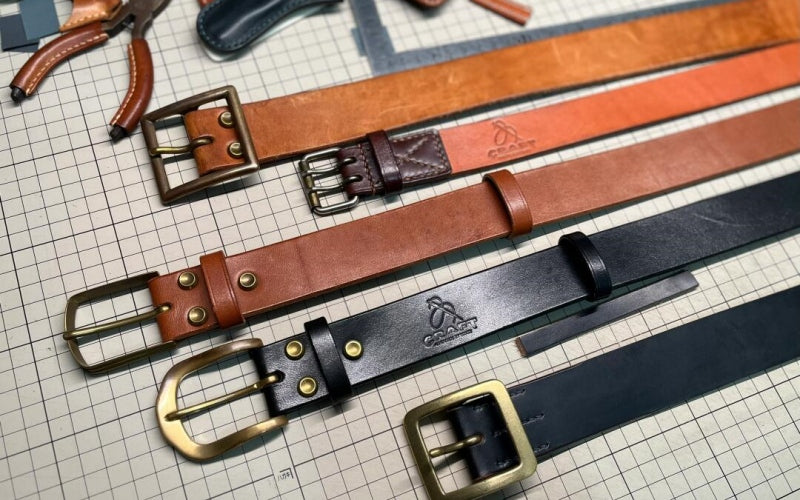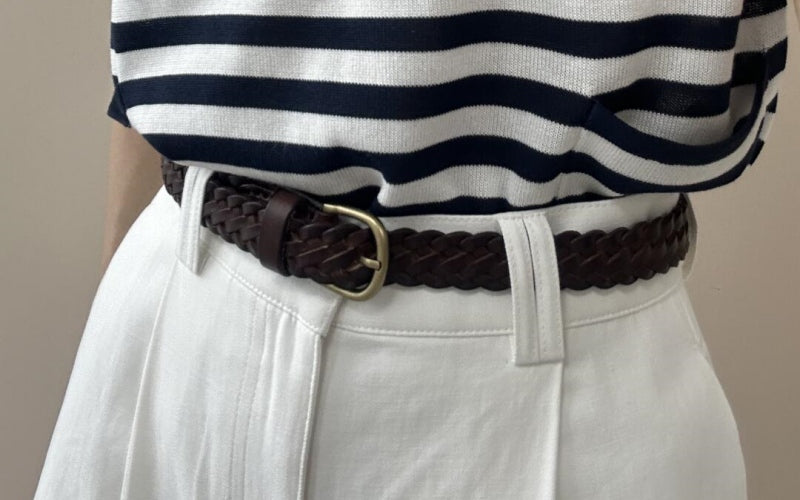
What Type of Leather Is Best for Belts? Your Ultimate Guide
Let’s cut through the noise: Not all leather is created equal. That “genuine leather” belt you bought on sale last year?
It’s probably already cracking, and no amount of conditioner will fix it.
At Beltley, where every stitch tells a story, we’re here to break down the real differences between leather types—so you can invest in a belt that ages like a fine wine, not a banana. Spoiler: The answer isn’t as simple as you think.
 Love this belt? Click the pic to see more just like it
Love this belt? Click the pic to see more just like it
The Leather Lowdown: Why Your Belt’s Material Matters
A belt isn’t just a functional accessory—it’s a daily companion. It survives coffee spills, subway crowds, and the occasional overindulgent brunch. The right leather doesn’t just endure; it evolves, developing a unique patina that whispers, “I’ve lived a life.” Here’s what you’re paying for:
-
Durability: Cheap leather cracks. Quality leather bends.
-
Comfort: Stiff belts dig. Soft leather molds to your body.
-
Aesthetic: That rich, worn-in look? Only premium leather delivers.
But with terms like full-grain, top-grain, and bonded thrown around, how do you choose? Let’s decode the jargon.
 Love this belt? Click the pic to see more just like it
Love this belt? Click the pic to see more just like it
The Contenders: 6 Types of Leather (Ranked from Worst to Best)
6. Bonded Leather – The “Fake It Till You Make It” Imposter
-
What It Is: Chopped-up scraps glued together and stamped with a faux grain.
-
Pros: Cheap (we’re talking $10 cheap).
-
Cons: Peels faster than a sunburned tourist. Avoid unless you enjoy rebuying belts yearly.
-
Beltley’s Take: “We’d rather sell cardboard belts.”
5. Genuine Leather – The Misleading Middle Child
-
What It Is: The bottom layer of the hide, sanded and painted to mimic quality.
-
Pros: More affordable than premium options.
-
Cons: Thin, prone to scuffs, and lacks character.
-
Beltley’s Take: “It’s like calling fast food ‘real cuisine.’ Technically true, but…”
 Love this belt? Click the pic to see more just like it
Love this belt? Click the pic to see more just like it
4. Split Leather – The Tough-But-Rough Option
-
What It Is: The fibrous part of the hide left after top layers are removed. Often used for suede.
-
Pros: Soft, breathable, and great for casual belts.
-
Cons: Weak structure. Over time, it stretches like yoga pants.
-
Beltley’s Pick: Our Weekender Suede Belt – perfect for lazy Sundays (but retire it after 2 years).
3. Top-Grain Leather – The Crowd-Pleaser
-
What It Is: The top layer of the hide, sanded to remove imperfections and coated for shine.
-
Pros: Smooth finish, scratch-resistant, and budget-friendly for semi-formal wear.
-
Cons: Lacks natural texture. The plastic-like coating (called a corrected finish) prevents patina.
-
Beltley’s Pick: The Executive Edge Belt – polished enough for boardrooms, priced under $150.
2. Full-Grain Leather – The Gold Standard
-
What It Is: The entire top layer of the hide, untouched by sanding or buffing. Natural marks (scars, insect bites) stay intact.
-
Pros:
-
Durability: Thick, dense fibers resist tears.
-
Breathability: Unlike plastic-coated leather, it molds to your body.
-
Patina: Ages like a Hollywood star—each scratch and crease adds character.
-
Cons: Pricier upfront (but cheaper long-term).
-
Beltley’s Hero: The Legacy Full-Grain Belt – hand-stained in Italy, guaranteed for life.
 Love this belt? Click the pic to see more just like it
Love this belt? Click the pic to see more just like it
1. Shell Cordovan – The Unicorn of Leathers
-
What It Is: A membrane from horse hides (not cows!), tanned for 6+ months. Only 8% of tanneries worldwide work with it.
-
Pros:
-
Waterproof: Oiled fibers repel rain and spills.
-
Luster: Develops a mirror-like shine with wear.
-
Rarity: Each belt is a limited-edition masterpiece.
-
Cons: Costs more than your car payment.
Tanning 101: Why the Process Matters More Than You Think
Leather isn’t just about the hide—it’s about how it’s tanned. This chemical process preserves the material and defines its soul.
Vegetable Tanning (The Artisan’s Choice)
-
Process: Uses natural tannins from tree bark. Takes 30–60 days.
-
Pros: Eco-friendly, develops a rich patina, and smells like a forest.
-
Cons: Fades in direct sunlight.
-
Beltley’s Use: 90% of our belts are vegetable-tanned.
Chrome Tanning (The Speed Demon)
-
Process: Uses chromium salts. Takes 1 day.
-
Pros: Cheap, water-resistant, and colorfast.
-
Cons: Toxic chemicals, lacks patina potential.
-
Beltley’s Stance: “We’d rather wait 60 days for perfection.”
Oil Tanning (The Rugged Rebel)
-
Process: Soaked in fish or synthetic oils.
-
Pros: Supremely soft and water-repellent.
-
Cons: Greasy feel that transfers to clothes.
-
Beltley’s Pick: Only for our Adventure Series Belts (built for hikers, not suits).
 Love this belt? Click the pic to see more just like it
Love this belt? Click the pic to see more just like it
The Beltley Difference: What Sets Our Leather Apart
We don’t just sell belts—we sell heirlooms. Here’s how we source and craft:
-
Ethical Sourcing: Our hides come from free-roaming European cattle (no factory farms).
-
Natural Dyes: Colors derived from walnuts, iron oxide, and indigo—no toxic chemicals.
-
Hand-Stitching: Each belt is sewn by artisans with 20+ years of experience (try finding that at a mall kiosk).
-
Zero Waste: Scraps become keychains or donated to local artists.
 Love this belt? Click the pic to see more just like it
Love this belt? Click the pic to see more just like it
Leather Care: How to Make Your Belt Last a Lifetime
A $500 belt can turn to trash if neglected. Follow these steps:
-
Clean Monthly: Wipe with a damp cloth. For stains, use saddle soap.
-
Condition Quarterly: Massage in Beltley’s Leather Elixir (contains beeswax and jojoba oil).
-
Store Properly: Hang or roll—never fold. Keep away from heat and sunlight.
-
Rotate Belts: Don’t wear the same one daily. Let it “rest” between uses.
Pro Tip: If your belt gets soaked, stuff it with newspaper to dry. Never use a hairdryer—unless you want a crispy belt.
 Love this belt? Click the pic to see more just like it
Love this belt? Click the pic to see more just like it
FAQs: Your Leather Belt Dilemmas, Solved
Q: Can vegan leather compare to the real thing?
A: Vegan “leather” (usually PVC or PU) cracks within a year. For eco-warriors, try our Cork Leather Belt – plant-based and durable.
Q: How do I spot fake leather?
A:
-
Smell It: Real leather smells earthy; fake smells like plastic.
-
Check the Edge: Genuine leather has a rough, fibrous edge; bonded leather looks like cardboard.
-
Burn Test: Real leather singes; fake melts. (But maybe don’t set fire to store merchandise.)
Q: Why does my belt squeak?
A: Friction between the leather and buckle. Rub a dab of beeswax on the inside—silence is golden.
Q: Are exotic leathers (alligator, ostrich) ethical?
A: At Beltley, we avoid exotic skins. But if you must, look for CITES certification to ensure humane sourcing.
Q: Can I repair a cracked belt?
A: If it’s full-grain, yes! Send it to us for a spa day. If it’s bonded leather… condolences.
The Final Verdict: What’s the Best Leather for Belts?
For 99% of people, full-grain vegetable-tanned leather is the answer. It’s tough, ages beautifully, and supports sustainable practices. But if you’re a collector or have a trust fund, shell cordovan is the holy grail.
At Beltley, we’re obsessed with crafting belts that outlive trends—and maybe even you. Because a belt shouldn’t just hold up your pants; it should hold up your legacy.
Ready to Invest in Forever? Explore Beltley’s leather collection here and use code BELTLEY15 for 15% off your first premium belt.

